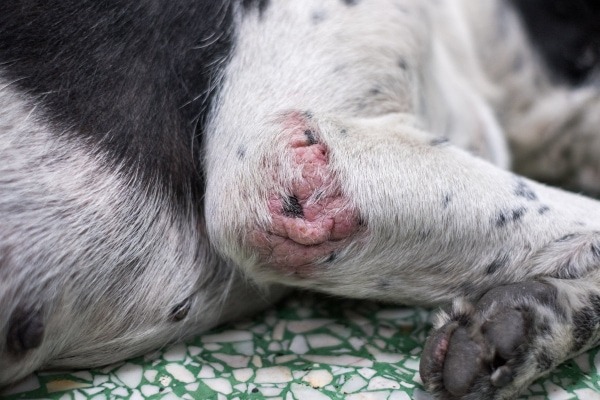To treat bed sores on dogs, clean the affected area and apply a veterinary-recommended ointment regularly. Bed sores, also known as pressure sores, can occur in dogs who are immobile for long periods, leading to tissue damage.
These sores are painful for the dog and can become infected if not treated promptly. To effectively treat bed sores on dogs, it’s important to provide proper wound care and prevent further pressure on the affected area. We’ll explore the causes of bed sores in dogs, the signs and symptoms to watch for, and the best practices for treating and preventing these painful sores.
We’ll also discuss when it’s necessary to seek veterinary care and additional tips for promoting healing and comfort for your furry companion.

Credit: www.handicappedpets.com
Understanding The Causes Of Bed Sores In Dogs
When treating bed sores on dogs, it’s crucial to understand their causes to approach the treatment effectively. Identifying the underlying factors such as prolonged pressure, friction, or moisture can help in preventing and healing bed sores in dogs. Proper care, including regular cleaning, changing bedding, and providing soft, supportive surfaces, also plays a key role in treating bed sores on dogs.
Understanding the Causes of Bed Sores in Dogs Bed sores, also known as pressure ulcers or decubitus ulcers, are a common issue for dogs, especially those who are elderly, paralyzed, or have mobility issues. These painful wounds can develop when a dog remains in one position for an extended period, causing pressure and friction on specific areas of the body. Additionally, impaired mobility and incontinence can contribute to the development of bed sores. Moisture and dirt can exacerbate the condition, making it crucial to keep your dog’s skin clean and dry.
Pressure Points And Friction
The primary cause of bed sores in dogs is prolonged pressure on specific areas such as bony prominences, where the skin is compressed against a hard surface. This restricts blood flow, leading to tissue damage and the formation of sores. Friction caused by dragging or sliding can also contribute to the development of bed sores in dogs.
Impaired Mobility
Dogs with limited mobility, such as those recovering from surgery, suffering from arthritis, or paralyzed, are at a higher risk of developing bed sores. The inability to change positions regularly puts pressure on specific areas of their body, making them more susceptible to the formation of sores.
Moisture And Dirt
Moisture and dirt can aggravate existing bed sores and increase the risk of infection. Dogs with incontinence issues are especially prone to developing bed sores due to prolonged exposure to urine and feces. Additionally, wet or soiled bedding can contribute to the development and worsening of bed sores in dogs. Understanding these causes is essential in preventing and treating bed sores in dogs. By addressing these underlying factors and taking proactive measures, dog owners can help alleviate their pets’ discomfort and support the healing process.
Recognizing Symptoms Of Bed Sores In Dogs
Bed sores in dogs can be painful and uncomfortable for your pet. Recognizing the symptoms early is crucial in order to treat them effectively. Look out for redness, swelling, and changes in behavior. Providing a comfortable, padded resting place and regular repositioning can help prevent and treat bed sores on dogs.
Recognizing Symptoms of Bed Sores in Dogs Bed sores, also known as pressure sores or decubitus ulcers, can be a source of discomfort for our furry companions. It’s essential to recognize the symptoms of bed sores in dogs early to prevent further complications. Here are some signs to watch out for:
Red, Inflamed Skin
red, inflamed skin around bony parts of the body. Pay close attention to areas where your dog tends to rest for long periods, such as the elbows, hips, or hocks. If you notice any redness or irritation, it could be indicative of the development of bed sores.
Open Wounds Or Blisters
open wounds or blisters. These can be painful for your dog and may lead to infection if left untreated. Be sure to inspect your dog’s skin regularly for any signs of open sores, as prompt attention is crucial for preventing further discomfort.
Unusual Behavior Or Discomfort
unusual behavior or discomfort in your dog. If they seem hesitant to lie down or exhibit signs of pain when sitting or standing, it could be a result of bed sores. Dogs may also excessively lick or groom affected areas, indicating their discomfort. Being attuned to these symptoms and seeking prompt veterinary care is essential for preventing bed sores from progressing and ensuring your dog’s comfort and well-being.
Creating A Comfortable Resting Area
Dogs with bed sores need proper care and attention to create a comfortable resting area that promotes healing. This involves providing a supportive bed, regularly changing bedding, and providing extra padding to alleviate pressure. These measures can significantly improve your furry friend’s comfort and aid in the healing process.
Choosing A Supportive Bed
Choosing a supportive bed is crucial in providing relief for dogs with bed sores. Opt for a bed with memory foam or orthopedic properties to help distribute your dog’s weight evenly and reduce pressure on the affected areas. Additionally, a bed with a soft, breathable fabric can help prevent further irritation.
Regularly Changing Bedding
Regularly changing the bedding is essential to maintain a clean and hygienic environment for your dog. Wash bedding with a mild detergent to prevent any bacterial or fungal infections from aggravating the bed sores. Keeping the bedding clean can aid in the healing process and prevent further discomfort.
Providing Extra Padding
Providing extra padding, such as cushions or blankets, can offer additional comfort and help to alleviate pressure on the affected areas. Placing these soft materials strategically on the bed can provide relief and support your dog’s body, reducing the risk of further bed sores.
Cleaning And Dressing The Wound
As part of the comprehensive care for your dog’s bed sores, cleaning and dressing the wound is a crucial step in the healing process. Properly cleaning and dressing the affected area can help prevent infection and promote healing. Here’s how to effectively clean and dress your dog’s bed sores.
Gently Cleaning The Affected Area
When cleaning your dog’s bed sores, it’s important to use a gentle approach to avoid causing further discomfort to your furry friend. Here are the steps to gently clean the affected area:
- Use a mild antiseptic solution recommended by your veterinarian to cleanse the wound.
- Gently wipe the area with a clean, soft cloth or gauze to remove any debris or discharge.
- Rinse the wound with lukewarm water to ensure all traces of the antiseptic solution are removed.
- Pat the area dry with a clean, soft towel or allow it to air dry before proceeding to the next step.
Applying A Veterinarian-recommended Dressing
After the affected area has been thoroughly cleaned, it’s essential to apply a veterinarian-recommended dressing to promote healing and protect the wound. Follow these steps to apply the dressing:
- Apply a thin layer of antibiotic ointment to the cleaned wound to prevent infection.
- Cover the wound with a non-adherent dressing pad to protect the area and absorb any discharge.
- Secure the dressing in place with a self-adhesive bandage that is snug but not too tight to allow proper circulation.
- Ensure the dressing is changed regularly as per your veterinarian’s instructions to keep the wound clean and promote healing.
Monitoring For Signs Of Infection
Once the dressing is applied, it’s important to monitor the wound for any signs of infection. Keep an eye out for the following indicators that may signify an infection:
- Increased redness, swelling, or warmth around the wound.
- Persistent or worsening discharge that is thick, yellow, or green in color.
- Foul odor emanating from the wound.
- Behavioral changes in your dog, such as increased discomfort, lethargy, or loss of appetite.
If you notice any of these signs, consult your veterinarian promptly for further evaluation and treatment.
Minimizing Pressure And Friction
One of the key aspects of treating bed sores on dogs is minimizing pressure and friction. By addressing these factors, you can help prevent the development and worsening of bed sores, also known as pressure ulcers, in your furry companion. Here are some effective strategies to minimize pressure and friction and aid in the healing process.
Encouraging Movement And Exercise
Encouraging your dog to move and engage in light exercise can help distribute pressure and reduce the likelihood of bed sores. Regular, gentle walks or supervised play sessions can promote circulation and alleviate prolonged pressure on specific areas. However, ensure that the level of activity is suitable for your dog’s condition and doesn’t cause discomfort.
Using Protective Clothing Or Bandages
Applying protective clothing or bandages to vulnerable areas can help minimize friction and cushion the skin, reducing the risk of bed sores. These specially designed garments can provide a barrier between the skin and any irritating surfaces, while aiding in the healing process.
Providing Regular Massages Or Repositioning
Regular massages and repositioning can help relieve pressure on specific areas and stimulate blood flow to promote healing. Gently massaging the affected areas can help alleviate tension and enhance circulation, while frequent repositioning can prevent prolonged pressure on particular spots.
Introducing Supplements For Skin Health
Omega-3 Fatty Acids
Omega-3 fatty acids play a crucial role in maintaining healthy skin and promoting healing. They help reduce inflammation and support skin barrier function, making them essential for treating bed sores on dogs. Additionally, Omega-3 fatty acids can improve overall skin health and reduce the risk of future skin issues.
Vitamin E
Vitamin E is a powerful antioxidant that can aid in the treatment of bed sores on dogs. It promotes skin healing and protects skin cells from damage caused by free radicals. When administered as a supplement, Vitamin E can accelerate the recovery process and support the rejuvenation of the affected skin.
Zinc
Zinc is an essential mineral for skin health, as it plays a key role in wound healing and tissue repair. When included in a dog’s diet as a supplement, zinc can help alleviate bed sores by promoting skin regeneration and strengthening the immune system’s response to the affected area.
Hydration And Nutrition
When it comes to treating bed sores on dogs, hydration and nutrition play a crucial role in the healing process. Proper hydration and a balanced diet are essential for maintaining the overall health and well-being of your furry friend, helping to promote tissue repair and prevent future sores from developing.
Providing Ample Fresh Water
Ensuring your dog has access to an abundant supply of fresh water is essential for preventing dehydration, promoting healthy skin, and supporting the healing process. Dehydrated skin is more prone to damage, so encouraging your dog to drink water regularly can help maintain skin elasticity and prevent the development of bed sores.
Offering High-quality, Balanced Meals
Feeding your dog a diet that is rich in nutrients and balanced in essential macro and micronutrients helps support overall health and provides the necessary building blocks for tissue repair. Opt for high-quality commercial dog food or consider preparing homemade meals using veterinarian-recommended recipes to ensure your dog receives a well-rounded, nutritious diet.
Promoting A Healthy Immune System
A healthy immune system is key to supporting your dog’s overall well-being and aiding in the healing process. Provide your dog with foods rich in antioxidants, vitamins, and minerals to boost their immune system and help fight off infections that can further complicate bed sore healing.
Seeking Professional Guidance
Understanding The Severity Of The Bed Sores
Bed sores, also known as pressure ulcers, can range from mild discomfort to severe tissue damage in dogs. It’s crucial to comprehend the severity of these sores in order to determine the appropriate treatment plan. Minor cases may be managed at home, while more advanced bed sores require professional intervention.
Discussing Tailored Treatment Options
Discussing the tailored treatment options with a veterinarian is essential when dealing with bed sores on dogs. Veterinarians can evaluate the specific condition and provide a customized plan to address the sores effectively. From topical medications to specialized wound care, tailored treatment options are crucial for promoting healing and preventing further complications.
Following The Veterinarian’s Care Plan
Following the veterinarian’s care plan diligently is paramount for the successful treatment of bed sores in dogs. Compliance with the prescribed medications, wound care routines, and lifestyle modifications is vital to ensure the sores heal properly. Regular follow-up appointments with the vet should also be upheld to monitor the progress and make any necessary adjustments to the treatment plan.
Regular Checkups And Skin Inspections
Regular checkups and skin inspections are crucial in preventing and treating bed sores in dogs. By monitoring the pressure points and skin condition of your furry friend, you can effectively identify any signs of discomfort or potential risk for bed sores. Additionally, adjusting the dog’s environment as needed and maintaining a proactive approach are essential in ensuring your dog’s well-being.
Monitoring Pressure Points And Skin Condition
When conducting regular checkups and skin inspections, pay close attention to the pressure points on your dog’s body, particularly areas where bones protrude or where the skin rubs against other body parts. These pressure points are more prone to developing bed sores, so it’s essential to keep a close eye on them. Check for any redness, swelling, or unusual sensitivity in these areas as early signs of bed sores.
Adjusting The Dog’s Environment As Needed
To prevent and treat bed sores, it’s important to make necessary adjustments to your dog’s environment. Ensure that your dog’s bedding is comfortable, supportive, and clean. Regularly change their position to relieve pressure on specific areas prone to bed sores. If your dog spends extended periods lying down, consider investing in therapeutic padding or cushions to alleviate pressure and promote proper circulation.
Maintaining A Proactive Approach
Consistent monitoring and vigilance play a critical role in avoiding bed sores. By maintaining a proactive approach, you can address any potential issues before they escalate. Keep an eye on your dog’s skin condition, and seek veterinary assistance if you notice any concerning changes. Regular grooming and hygiene practices also contribute to preventing skin irritation and reducing the risk of bed sores.
Frequently Asked Questions For How To Treat Bed Sores On Dogs
What Are Bed Sores In Dogs?
Bed sores, also known as pressure ulcers, are wounds that develop from prolonged pressure on a specific area of a dog’s body. They are commonly seen in senior and immobilized dogs and should be treated promptly to prevent infection and discomfort.
How To Prevent Bed Sores In Dogs?
To prevent bed sores in dogs, it’s essential to provide them with soft and padded bedding, change their position regularly, and keep their skin clean and dry. Regular exercise and a balanced diet can also help maintain healthy skin and prevent the development of bed sores.
What Are The Treatment Options For Bed Sores In Dogs?
Treatment options for bed sores in dogs may include cleaning the wound, applying topical medications, and using protective bandages. In severe cases, surgery may be necessary to remove damaged tissue. It’s important to consult a veterinarian for proper diagnosis and treatment plan tailored to the dog’s specific condition.
When Should I Seek Veterinary Care For My Dog’s Bed Sores?
If you notice any signs of bed sores on your dog, such as redness, swelling, or a foul odor from the wound, it’s crucial to seek veterinary care promptly. Early intervention can prevent the worsening of the condition and ensure the appropriate treatment is administered for your dog’s comfort and well-being.
Conclusion
In caring for your dog, treating bed sores is essential. By following these practical steps, you can provide comfort and promote healing for your furry friend. Remember, frequent monitoring and veterinary support are crucial. With proper care and attention, you can help your dog recover from bed sores and enjoy a healthier, happier life.



